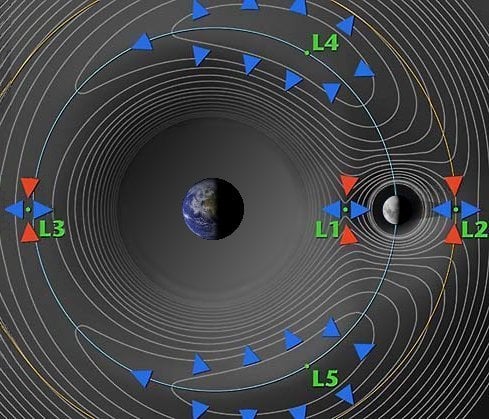A team of Hungarian scientists discovered two dust clouds orbiting Earth and have now proposed the existence of a dust moon. This is not the first time this term has been mentioned. Scientists have been debating and theorizing about the existence of dust moons for about 60 years, but finally, the theory seems to start making sense.
The team of scientists published their findings in the Monthly Notices of the Royal Astronomical Society (MNRAS). They discovered two dust clouds about 250,000 miles from Earth. That puts them roughly the same distance away as the distance to Earth’s actual moon, the planet’s only natural satellite.
Scientists believe the two dust clouds are located in areas where gravitational stability prevails, known as Lagrange points L4 and L5, which are caused by Earth’s and the moon’s gravity. The points move around Earth as moon orbits, creating a triangle. The dust clouds “move ahead of and behind the moon in orbit,” EarthSky explained.
Initially, Polish astronomer Kazimierz Kordylewski spotted hints of dust at L5 in 1961. However, because they were faint, the clouds didn’t offer any firm evidence to Kordylewski.
To prove their findings, the team of scientists who wrote the recent paper used a private observatory belonging to study co-author Judit Sliz-Balogh in Badacsonytördemic, Hungary. They took long exposures of L5, demonstrating that the light was reflecting the dust.
Their observations were matched with a prediction made by researchers in an older paper and with the observations of Kordylewski. Focusing on an explanation for the two dust clouds, the team also cleared Earth-based interference from the list of possible reasons.
“The Kordylewski clouds are two of the toughest objects to find, and though they are as close to Earth as the Moon are largely overlooked by researchers in astronomy,” Slíz-Balogh said in a statement. “It is intriguing to confirm that our planet has dusty pseudo-satellites in orbit alongside our lunar neighbour.”
Not everything has been proven, however. The scientists noted that the two clouds of dust could just be passing by, which would mean that it’s unclear why they got stuck in the L4 or L5 positions since other attempts to discover dust moons haven’t been so successful.
“The KDC [Kordylewski dust clouds] may be a transient [short-lived] phenomenon,” the team wrote in their paper. “[T]he probability of dust particles being trapped is random due to the occasional incoming of particles and their incidental velocity vectors. Therefore, the structure and particle density of the KDC is not constant.”
Nevertheless, this doesn’t mean the discovery is any less interesting. If proof emerges, that means there is much more going around our planet than what is currently known. The team also suggests future missions could be made to sample the dust found in those regions. Moreover, scientists could learn from the dust so they can build spacecraft that won’t collide with the dust that floats around our planet.





